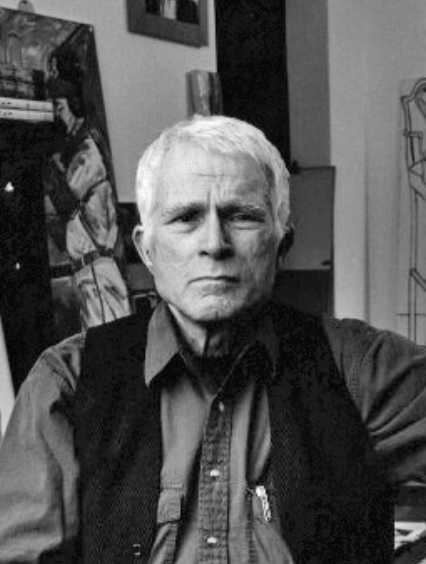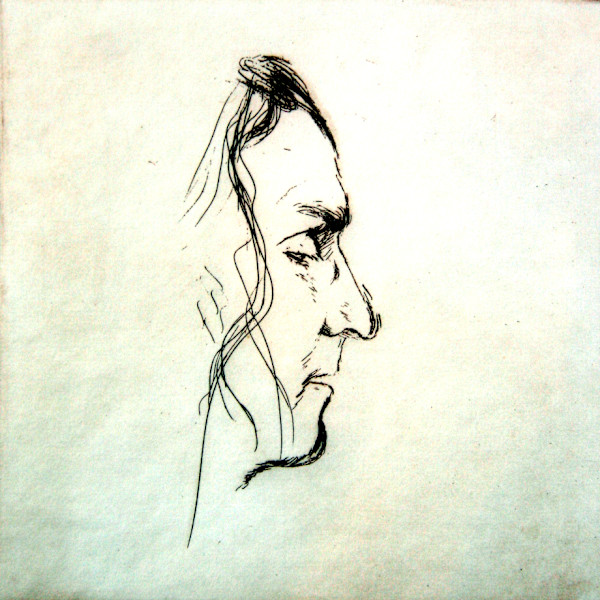
-
Artist: Ronald Brooks Kitaj (American, 1932-2007)
Ronald Brooks Kitaj (1932–2007) was an American-born artist who became a key figure in the British art scene during the mid-20th century. He is best known for his complex, often intellectual figurative paintings that blend references from literature, philosophy, history, and politics with a distinctive personal style. Kitaj was associated with the School of London, a group of figurative painters that included Lucian Freud, David Hockney, and Francis Bacon.
Early Life and Education:
Born: October 29, 1932, in Cleveland, Ohio.
Kitaj had a Jewish background, which deeply influenced his work, particularly his interest in Jewish identity and history.
After serving in the U.S. Merchant Marine and the U.S. Army, Kitaj used the GI Bill to study at the Ruskin School of Drawing and Fine Art at Oxford and later at the Royal College of Art in London, where he became close to David Hockney.
Artistic Style:
Kitaj's work is characterized by:
Figurative Painting: He rejected the abstract expressionism that dominated much of post-war art and instead focused on figurative art. His paintings often depict human figures in ambiguous, layered scenes.
Interdisciplinary Influence: His work is infused with references to history, literature, philosophy, and politics, and his canvases often appear as visual representations of ideas. He explored themes of identity, exile, and memory, influenced by his Jewish heritage and the European intellectual tradition.
Narrative Complexity: Kitaj's paintings often combine fragmented images with cryptic narratives. He used dense layers of symbolism and visual clues to create intricate and sometimes challenging compositions that invite viewers to engage deeply with the work.
Notable Works:
"The Ohio Gang" (1964): This is one of Kitaj’s best-known early works, a group portrait of influential figures from his youth in Ohio. It is a striking example of his blend of personal memory with historical reference.
"The Autumn of Central Paris" (1972–73): This painting captures Kitaj’s interest in the French poet Charles Baudelaire and his concept of the "flâneur" (a detached observer of urban life), blending vibrant colors and fragmented imagery to explore themes of alienation and modernity.
"If Not, Not" (1975): One of Kitaj’s most powerful works, this large canvas features a dystopian vision that combines Holocaust references with religious and mythological imagery, reflecting his engagement with Jewish identity and history.
Later Life and Legacy:
Controversial Exhibition: In 1994, Kitaj held a retrospective at the Tate Gallery in London. While the exhibition was intended to be a celebration of his career, it received harsh criticism from many reviewers. Kitaj blamed the negative reception for contributing to the untimely death of his wife, Sandra Fisher, shortly after the show. This tragedy profoundly affected him, and he later left London to return to Los Angeles.
Return to the U.S.: After moving back to the U.S., Kitaj's later works became more introspective, frequently reflecting on personal loss, his Jewish identity, and themes of exile and diaspora.
Death: Kitaj passed away in 2007 in Los Angeles.
Influence and Legacy:
Kitaj was a key figure in reviving figurative art during a period dominated by abstraction and conceptualism. His work influenced many artists, including David Hockney and Lucian Freud.
His "diasporist" theory—his concept of living in exile and expressing Jewish and intellectual identity through art—became central to his late works.
Kitaj remains an important figure for his contributions to modern figurative art, blending the personal with the universal and consistently challenging both viewers and critics with his intellectually dense and narratively rich compositions.
Today, Kitaj's works are held in major collections around the world, including the Tate Modern in London, the Museum of Modern Art in New York, and the Los Angeles County Museum of Art (LACMA). His career, while marked by both acclaim and controversy, left an enduring impact on contemporary art.
Powered by Artwork Archive
